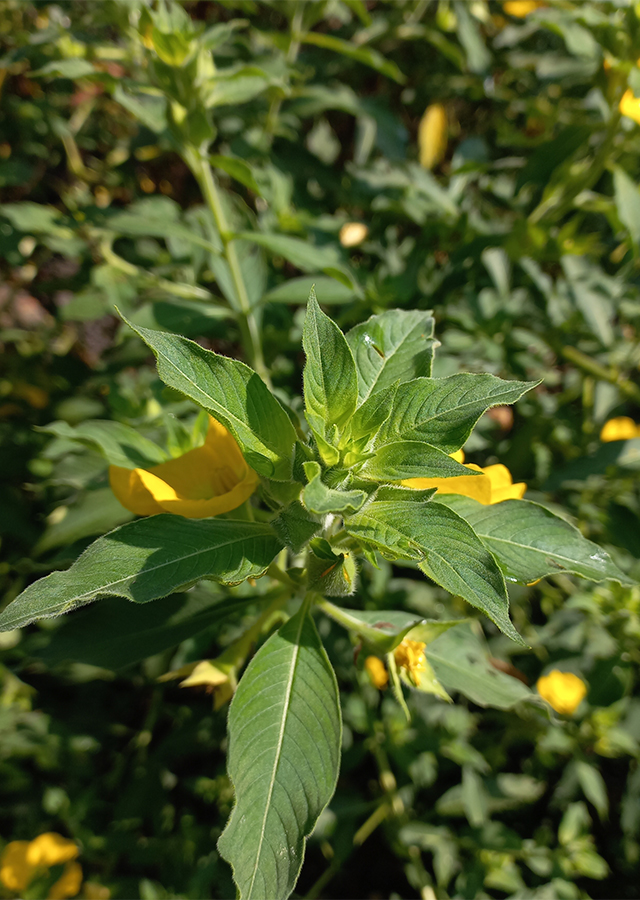Primrose Willow
Ludwigia octovalvis (Jacq.) P.H.Raven
Onagraceae
Location in our garden
Principal



Synonym
Jussiaea octovalvis (Jacq.) Sw.
Oenothera octovalvis Jacq.
Habitus
Herbaceous. A robust, well-branched perennial herb, grows up to 4 m tall, sometimes becoming woody at base.
Part Used
Leaves
Roots
The Whole Plant
Growing Requirements
Full Sunshine
Habitat
Aquatic
Wetland
Riverbanks
Grassland
Terrestrial
Overview
Primrose willow is a weed of rice, that native to Pantropical. It is distribution throughout the tropics, so that its original range cannot be known. It is listed as 'Invasive' in some Pacific Islands. This species is one of the plants that could grow and survive in the petrosludge and probably use heavy metals for phytoremediation. The plant is sometimes gathered from the wild for local medicinal use. It is a traditionally used medicinal plant in Malaysia and India. In Malay traditional medicine, it used to treat gastrointestinal complaints such as diarrhea and dysentery. In India, it used to treat eczematous lesions and relief of cough and cold. Beside of that, leaves used for tea by the Malay.
Vernacular Names
Herbe à pique (French), Clavito, Hierta de Santa Cruz (Spanish), Buyang samalam, Lakom ayer, Pujang malam (Malaysia), Tayilakton (Tagalog), Muương dất (Vietnam), Panijalokia, Kabo kaji (India), Thian nam, Yaa raknaa (Thai), Cao li jin chai, Cao long, Shui ding xiang, Zhen tong ci, Shui long, Shui yang cao, Sao guo cao (Chinese).
Agroecology
Primrose willow is found in wet or humid places, damp grassland, ditches, by water-courses, swamps, lakes and pools, drains, sandy or silty floodbanks, usually associated with agriculture and most commonly in either rainfed or irrigated ricefields. Its found from sea level to 1,500 m elevation. It is highly tolerant of fluctuating water levels. The periderm of the plant tissues swells rapidly when immersed in water, this is probably a defence against waterlogging. It prefers full sun and tolerates no more than side shade. The species grows singly or in clumps.
Morphology
- Roots - Has two types of roots, one anchors the plant to the soil (taproot), whilst the other, which looks like tiny bananas, contains air sacs that keep the plant afloat, and assist respiration.
- Stem - Have much branched, sometimes woody at base, hirstute, ribbed, red-brown.
- Leaves - Alternate, unifoliate, narrowly lanceolate to narrowly ovate, base narrowly cuneate, apex attenuate, main veins 11-20 on each side of midrib, light green and turn reddish upon aging, hirstute. Leaf-stalk short.
- Flowers - Sepals 4, ovate or lanceolate. Petals 4 and arranged in a cross-like pattern, yellow, broadly obovate or cuneate, slightly emarginate, the tip of the petal is sometimes folded down, forming a large notch-like indentation. The petals have distinct sunken venation which creates a rippled surface. Stamens 8, pale-greenish-yellow. Flowers occur singly in leaf axils and at branch ends.
- Fruits - Capsule, thin-walled, reddish brown, splits into 8 linear lobes.
- Seeds - Numerous, pluriseriate in each locule of thin-walled capsule, brown, rounded.
Cultivation
Propagated by seed.
Chemical Constituents
Alkaloids, tannin, saponin, phenol, steroids, beta-sitosterol, oleanolic acid, 2alpha-hydroxy ursolic acid, tormentic acid, daucosterol, maltol, methyl brevifolincarboxylate, 3, 4, 8, 9, 10-pentahydroxydibenzo[b,d]pyran-6-one, ellagic acid, luteolin, quercetin, apigenin, gallic acid, (23Z)-coumaroylhederagenin, (23E)-coumaroylhederagenin, (3Z)-coumaroylhederagenin.
Traditional Medicinal Uses
- The plant is considered to have carminative, laxative, vermifuge, astringent, diuretic, emmenagogue.
- Studies have shown antipyretic, antioxidant, antibacterial, hepatoprotective, antiproliferative, antidiabetic properties.
- It is used in the treatment of diarrhoea, dysentery, nervous diseases, rheumatic pains, chickenpox lesions. Sometimes used as a treatment against ulcerations of the nose.
- The mucilaginous leaves are used as a poultice to treat a variety of complaints, including headaches, orchitis and swollen glands in the neck.
- In India, leaf paste applied externally to eczematous lesions, especially old age eczema.
- In India, leaf juice used for intermittent fever and elief of cough and cold.
- Roots used for skin diseases. The Keffi people in Nigeria use roots to treat dermatosis; root extract in water taken orally three time daily to treat any skin injury.
Part Used
Reference Sources
- CAB International. 2021. Invasive Species Compendium: Ludwigia octovalvis (primrose willow). https://www.cabi.org/isc/datasheet/31671#toPictures.
- Flora Fauna Web. 2020. Ludwigia octovalvis (Jacq.) P.H. Raven. https://www.nparks.gov.sg/florafaunaweb/flora/4/8/4862
- Useful Tropical Plants Database. 2021. Ludwigia octovalvis. http://tropical.theferns.info/viewtropical.php?id=Ludwigia+octovalvis
- PROSEA. 2016. Ludwigia octovalvis (PROSEA). https://uses.plantnet-project.org/en/Ludwigia_octovalvis_(PROSEA).
- Setyawati,T., Narulita, S., Bahri I.P., and Rahardjo,G.T., 2015. A Guide Book to Invasive Alien Plant Species in Indonesia. Research, Development and Innovation Agency. Ministry of Environment and Forestry.
- Stuatxchange. 2018. Philippine Medicinal Plants: Malapako. http://www.stuartxchange.org/Malapako.html. 4-11-2021.

